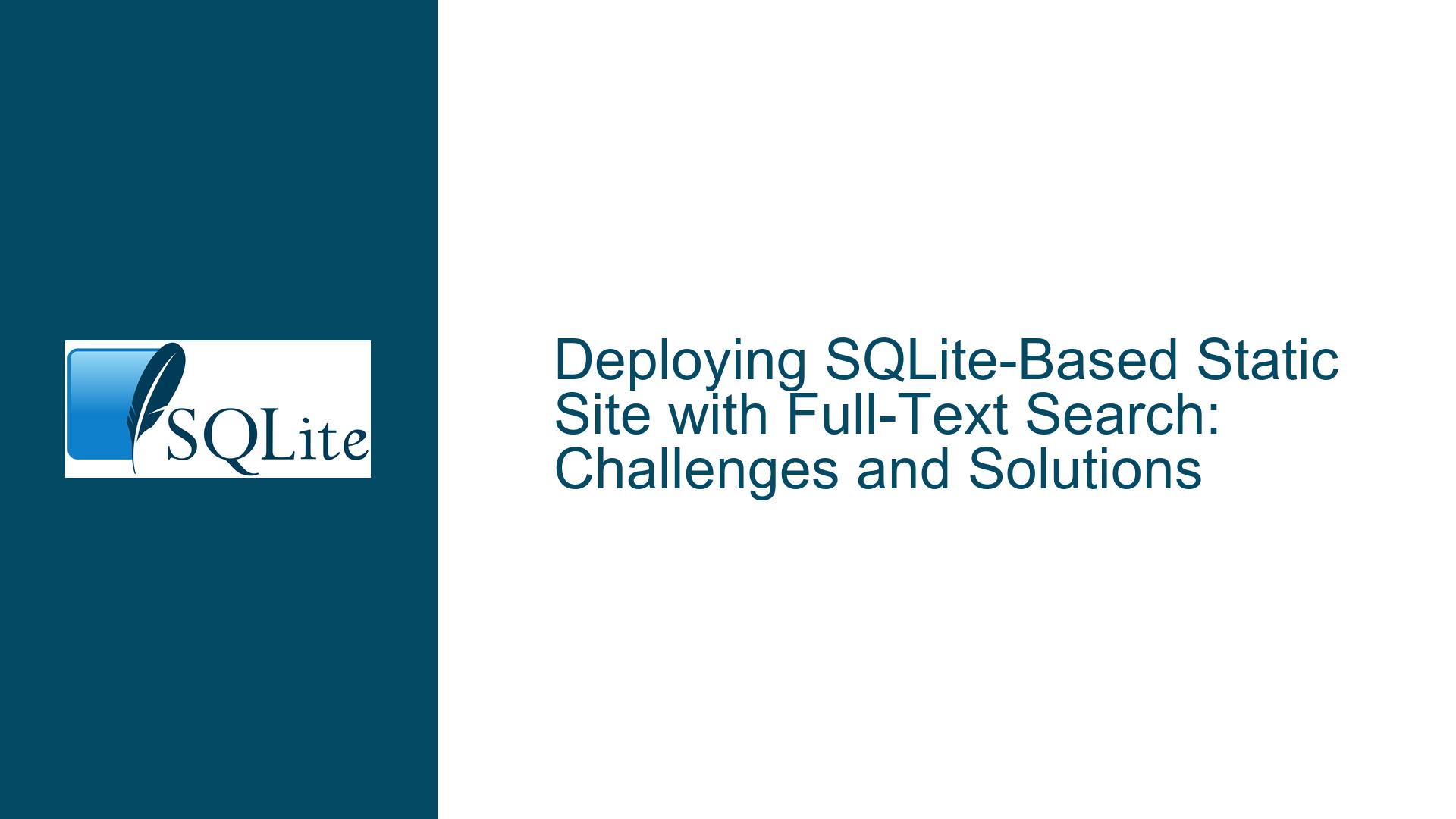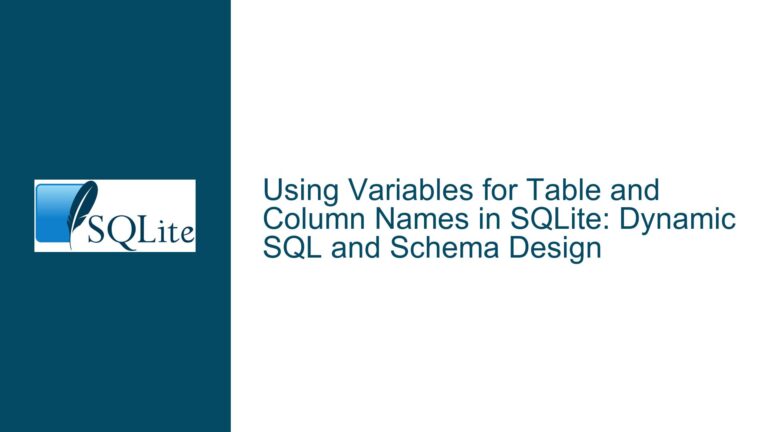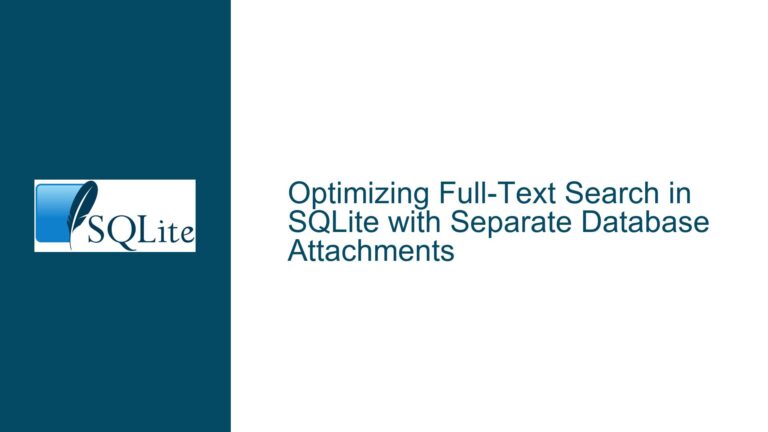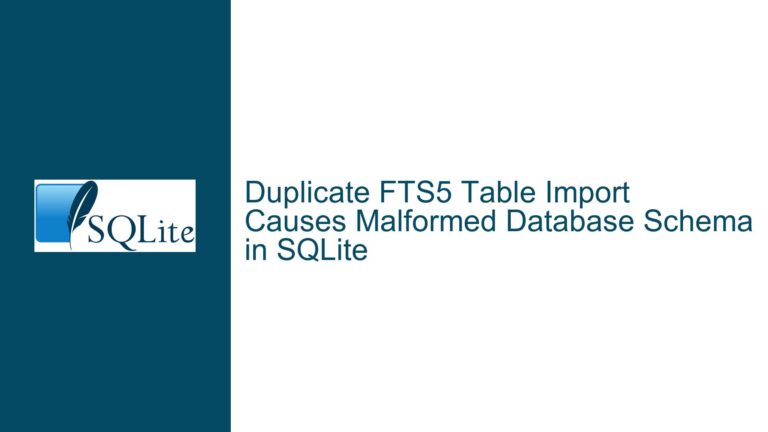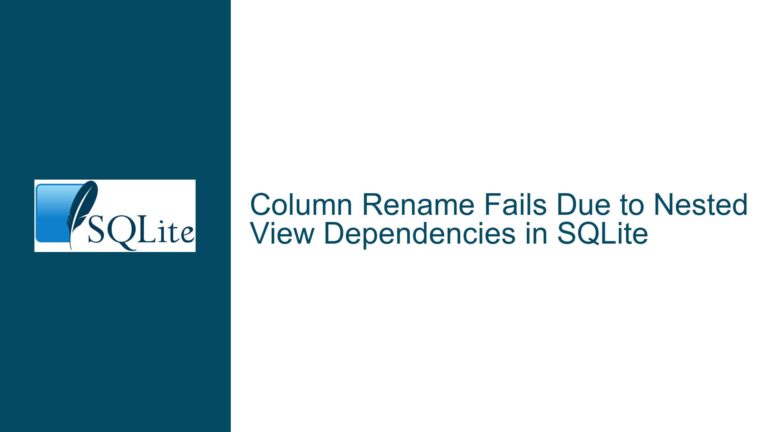Deploying SQLite-Based Static Site with Full-Text Search: Challenges and Solutions
Integrating Markdown, Images, and Full-Text Search in a Single-File SQLite Archive
The core challenge involves creating a self-contained application that combines markdown files, images, and full-text search capabilities within a SQLite database. The system must serve as both a content repository (via the sqlar table) and a search engine (via FTS5), while allowing deployment as a minimal set of files—ideally a single executable paired with the database or merged into one file. Key obstacles include efficient storage of binary assets (images), integration of FTS5 for real-time search, and ensuring compatibility with static hosting environments like GitHub Pages. Additional complexities arise from client-side security restrictions blocking local JavaScript execution and the need for offline accessibility without server dependencies.
Storage and Search Architecture in SQLite
The sqlar table schema stores compressed files, making it suitable for markdown and image assets. However, FTS5 virtual tables require careful configuration to index text content without interfering with binary data. A common oversight is attempting to index compressed markdown directly from sqlar, which fails because FTS5 cannot parse compressed blobs. Instead, a separate table or view must decompress content on the fly or store uncompressed text alongside compressed binaries. For example, a documents table might store raw markdown text for FTS5 indexing, while sqlar retains compressed versions for archival.
Another architectural consideration is the handling of image metadata. While sqlar can store images as blobs, relational tables should track their associations with markdown files. A junction table linking document IDs to image IDs ensures efficient retrieval during rendering. Without this, queries may require scanning the entire sqlar table for matching filenames, leading to performance degradation as the dataset grows.
Deployment Constraints and Client-Side Execution
Deploying the system as a standalone executable or CGI application introduces challenges in managing database connections and concurrent access. SQLite’s write-ahead logging (WAL) mode can mitigate locking issues in read-heavy scenarios, but CGI environments often require stateless request handling, complicating persistent connections. Solutions like sqliterg or ws4sqlite embed an HTTP server directly into the application, enabling RESTful API access to the database. However, these tools may not support advanced features like WebSocket-based real-time updates or server-side rendering of markdown.
For client-only deployments (e.g., GitHub Pages), JavaScript-based SQLite libraries like sql.js-httpvfs enable read-only access to the database via HTTP range requests. This approach avoids server-side processing but imposes limitations: search queries must be pre-defined or restricted to simple filters, as complex FTS5 operations may exceed browser memory limits. Additionally, browsers block JavaScript execution from local HTML files referencing external scripts, necessitating workarounds such as embedding all dependencies inline or using browser extensions to relax security policies.
Performance Bottlenecks in FTS5 Indexing and Query Execution
FTS5’s default configuration prioritizes query flexibility over performance, which becomes problematic when indexing large markdown repositories. A frequent mistake is omitting tokenizer customization. The porter tokenizer, for example, stems words to improve search recall but increases index size. For technical documentation containing code snippets or unique identifiers, the unicode61 tokenizer with remove_diacritics=0 may yield better results.
Index fragmentation is another concern. FTS5’s incremental updates can lead to unbalanced segment trees, slowing query response times. Periodically rebuilding the entire index with INSERT INTO fts_table(fts_table) VALUES('rebuild') mitigates this but requires downtime. Alternatively, using the merge command with a configured mergesize value balances maintenance overhead with query performance.
Concurrency during index updates poses risks in CGI environments. If multiple processes attempt to modify the FTS5 index simultaneously, database locks or corruption may occur. WAL mode allows readers to coexist with a single writer, but write-heavy workloads still benefit from queueing update requests through a dedicated process or using a mutex mechanism in the application layer.
Strategies for Single-File Deployment and Offline Accessibility
The AppendVFS module (appendvfs.c) allows appending a SQLite database to an executable, creating a self-contained binary. However, this requires custom compilation flags and careful handling of file I/O to avoid overwriting the appended database. For cross-platform compatibility, the application must detect whether it’s running in append mode and adjust file paths accordingly.
WebAssembly (WASM) offers a promising path for client-side execution without local installations. Compiling SQLite to WASM with Emscripten enables in-browser database operations, including FTS5 queries. However, loading large databases (>100MB) into memory may crash browsers or trigger out-of-memory errors. Chunked loading via sql.js-httpvfs alleviates this by fetching only necessary database pages via HTTP range requests, but this requires a web server supporting partial content requests—a feature absent in static hosts like GitHub Pages.
For air-gapped environments, embedding the entire database and WASM runtime into a single HTML file ensures offline access. Tools like webpack or rollup bundle JavaScript, CSS, and binary assets into one file. This monolithic approach sacrifices modularity but guarantees functionality in restricted networks. Note that iOS Safari imposes strict memory limits on WebAssembly, capping database sizes at approximately 500MB.
Step-by-Step Implementation Guide for a Hybrid CLI/CGI Application
Database Schema Design:
Create separate tables for raw markdown content (documents), FTS5 indexes (docs_fts), and archived files (sqlar). Use triggers to synchronize changes:CREATE TABLE documents ( id INTEGER PRIMARY KEY, path TEXT UNIQUE, content TEXT ); CREATE VIRTUAL TABLE docs_fts USING fts5(content, tokenize='unicode61'); CREATE TRIGGER docs_ai AFTER INSERT ON documents BEGIN INSERT INTO docs_fts (rowid, content) VALUES (new.id, new.content); END;Populate
sqlarusing thesqlar_compress()function during batch imports.CGI Request Handling:
Implement a lightweight CGI script in Python or C that parses query parameters, executes SQL queries, and returns rendered markdown or search results. Use thesqlite3module’s connection pool to reuse database handles across requests. For security, sanitize inputs with parameterized queries:import sqlite3 from markdown import markdown conn = sqlite3.connect('archive.db') cursor = conn.cursor() query = request.params.get('q') cursor.execute("SELECT snippet(docs_fts, 0, '', '', '', 32) FROM docs_fts WHERE content MATCH ?", (query,)) results = cursor.fetchall() print(f"Content-Type: text/html\n\n{markdown(results)}")Client-Side Rendering with Service Workers:
For offline access, register a service worker to cache the SQLite database and HTML/JS assets. UseIndexedDBas a fallback storage layer if WebAssembly SQLite exceeds memory limits. Implement search functionality with a web worker to avoid blocking the UI thread during FTS5 queries.AppendVFS Integration:
Compile the application withappendvfs.cand link it as the default VFS. During startup, check if the database is appended to the executable:sqlite3_open_v2("file:executable?append=1", &db, SQLITE_OPEN_READWRITE, "appendvfs");Ensure read-write operations occur on a temporary copy if the host filesystem is read-only.
Security Hardening:
Disable dangerous SQLite pragmas likeLOAD_EXTENSIONand enforce a strict Content Security Policy (CSP) when serving the client interface. UsePRAGMA trusted_schema=OFFto prevent malicious schema modifications.
By addressing these components systematically, the final deployment achieves a balance between portability, performance, and usability—delivering a robust solution for managing large markdown archives with integrated search.
